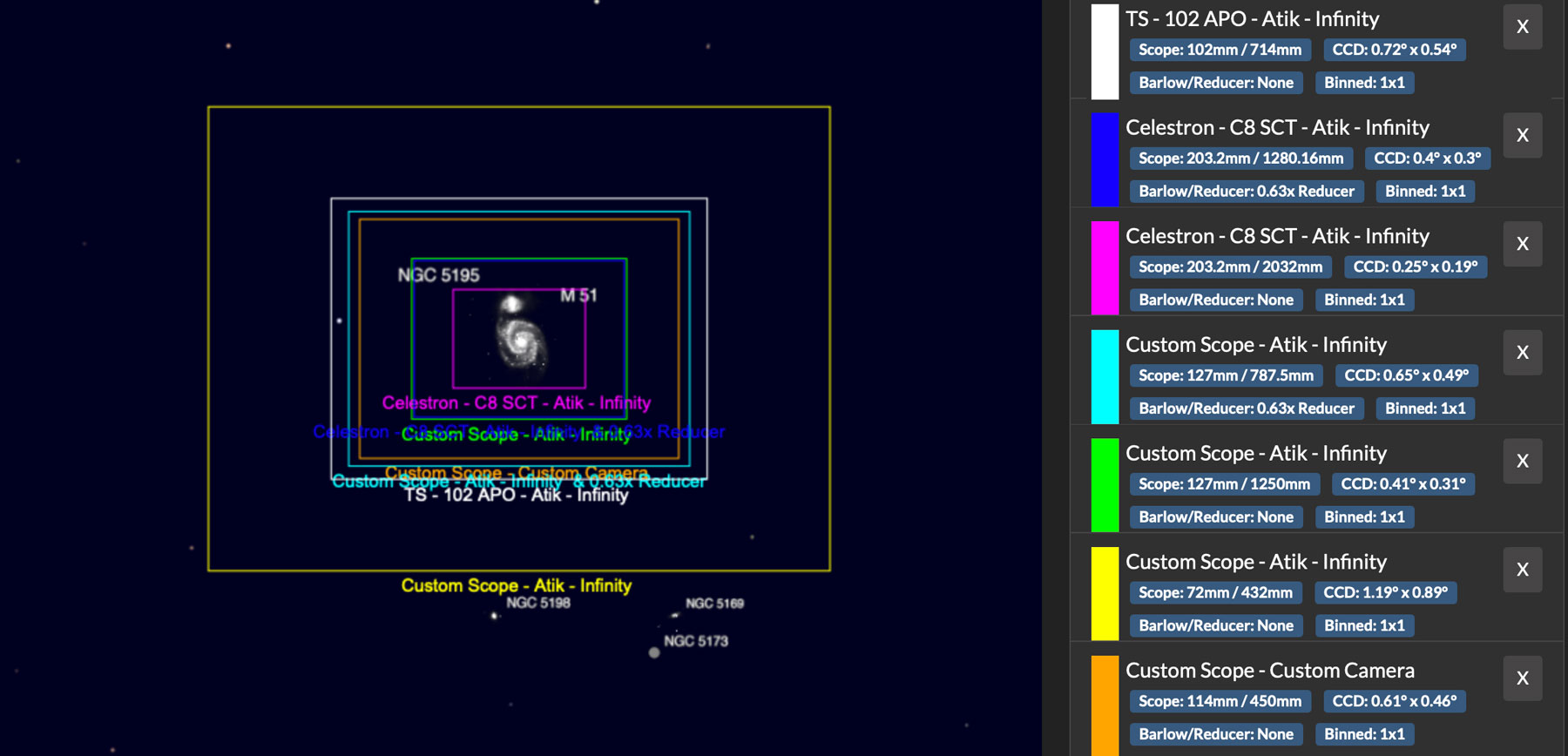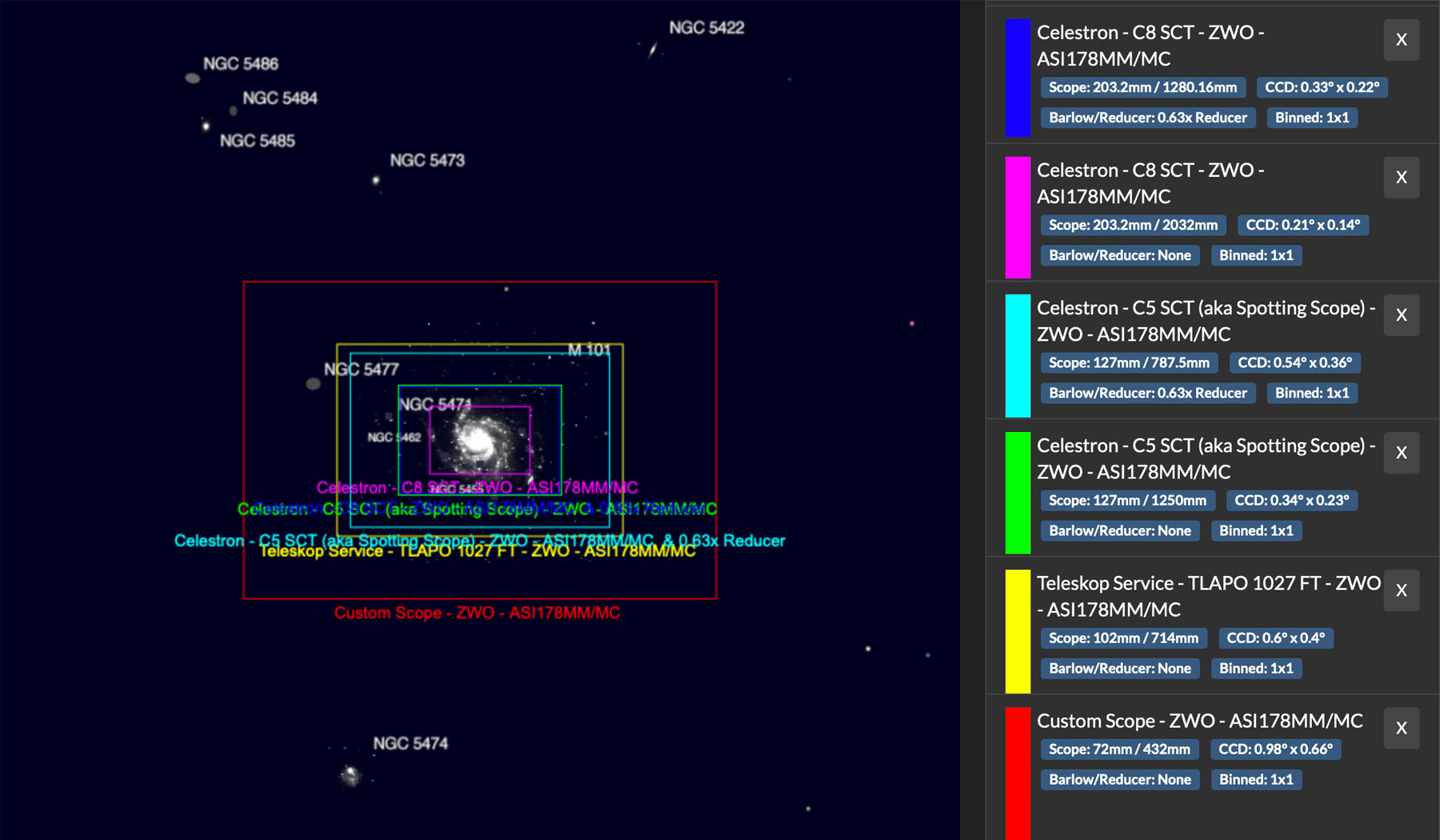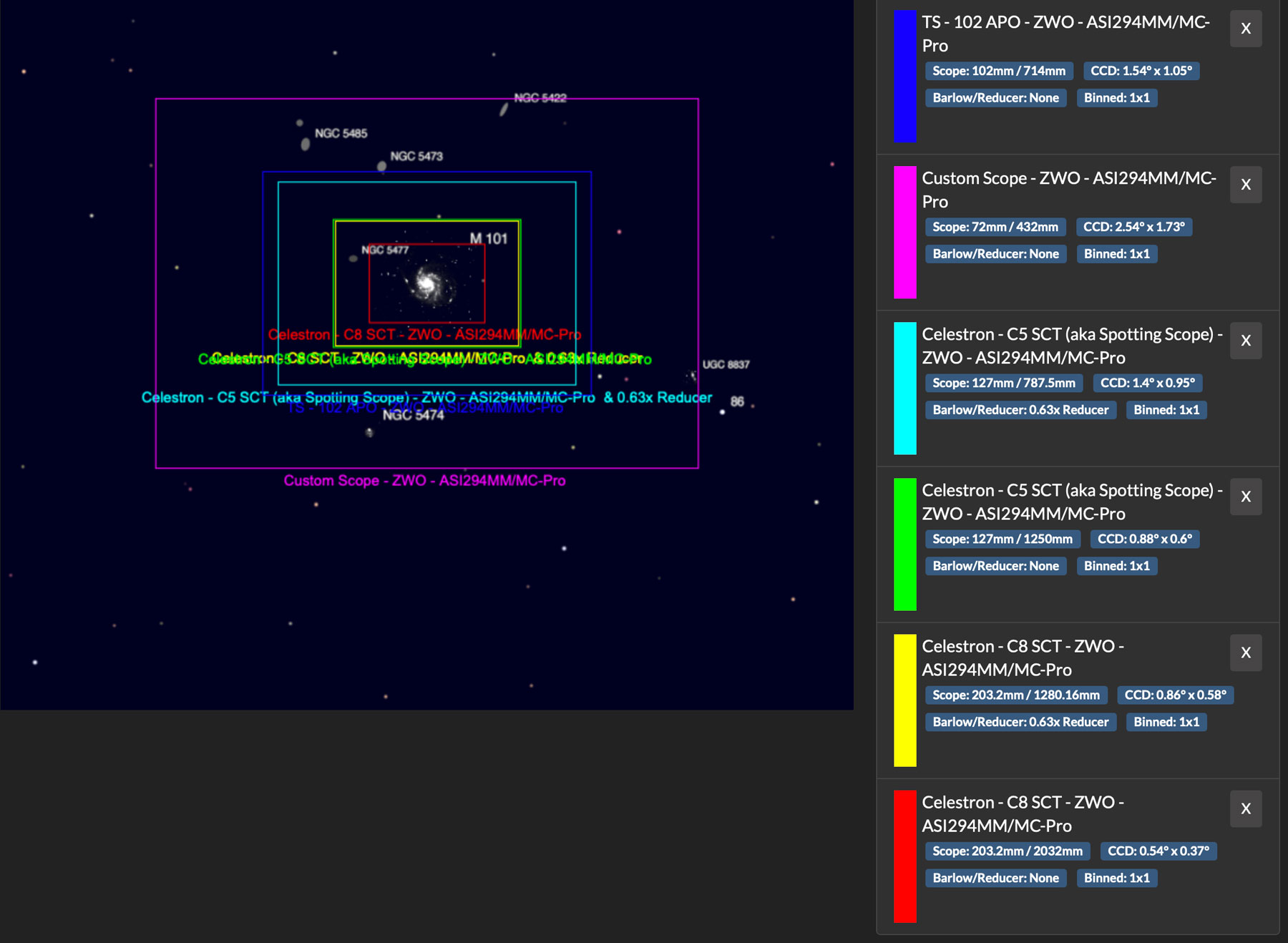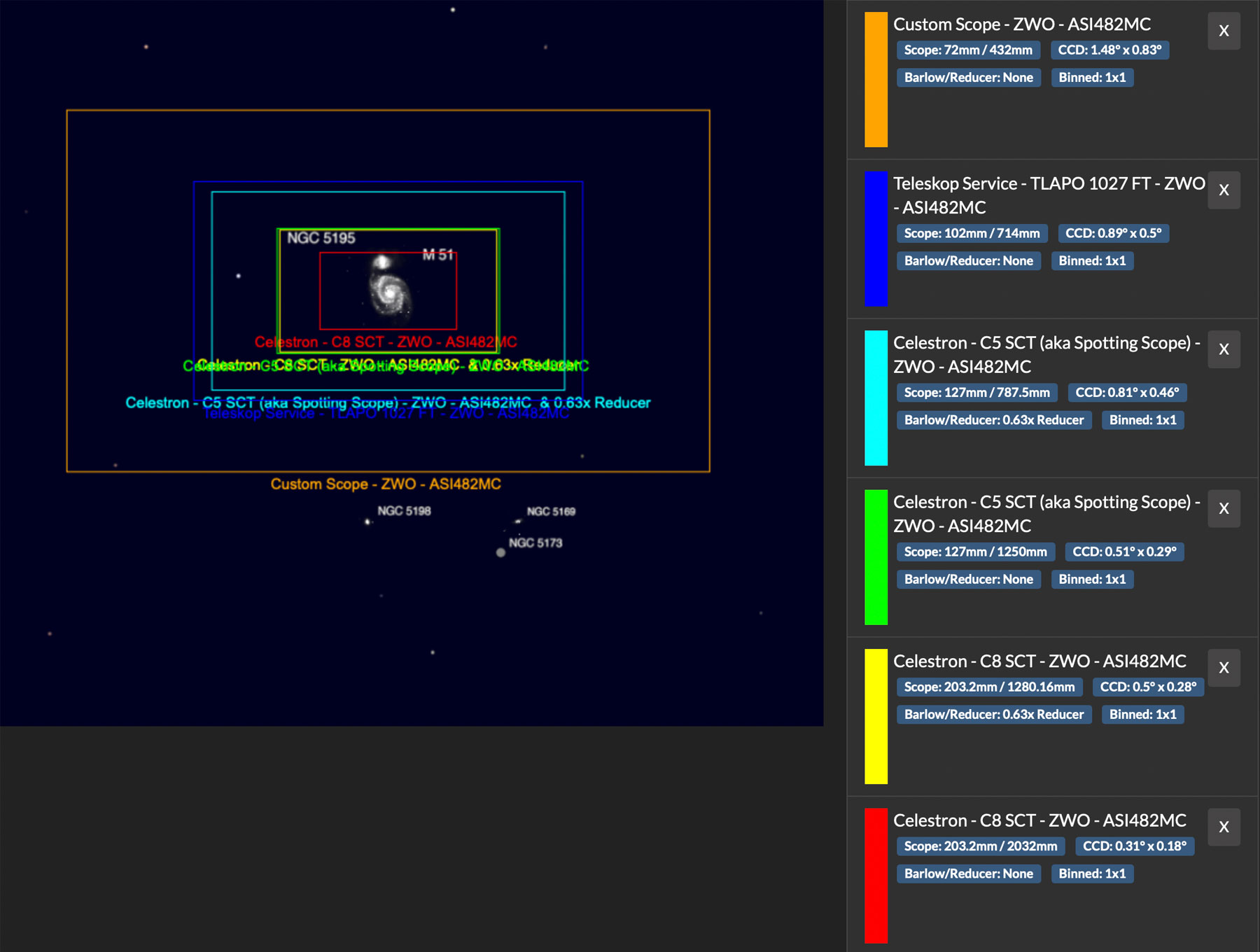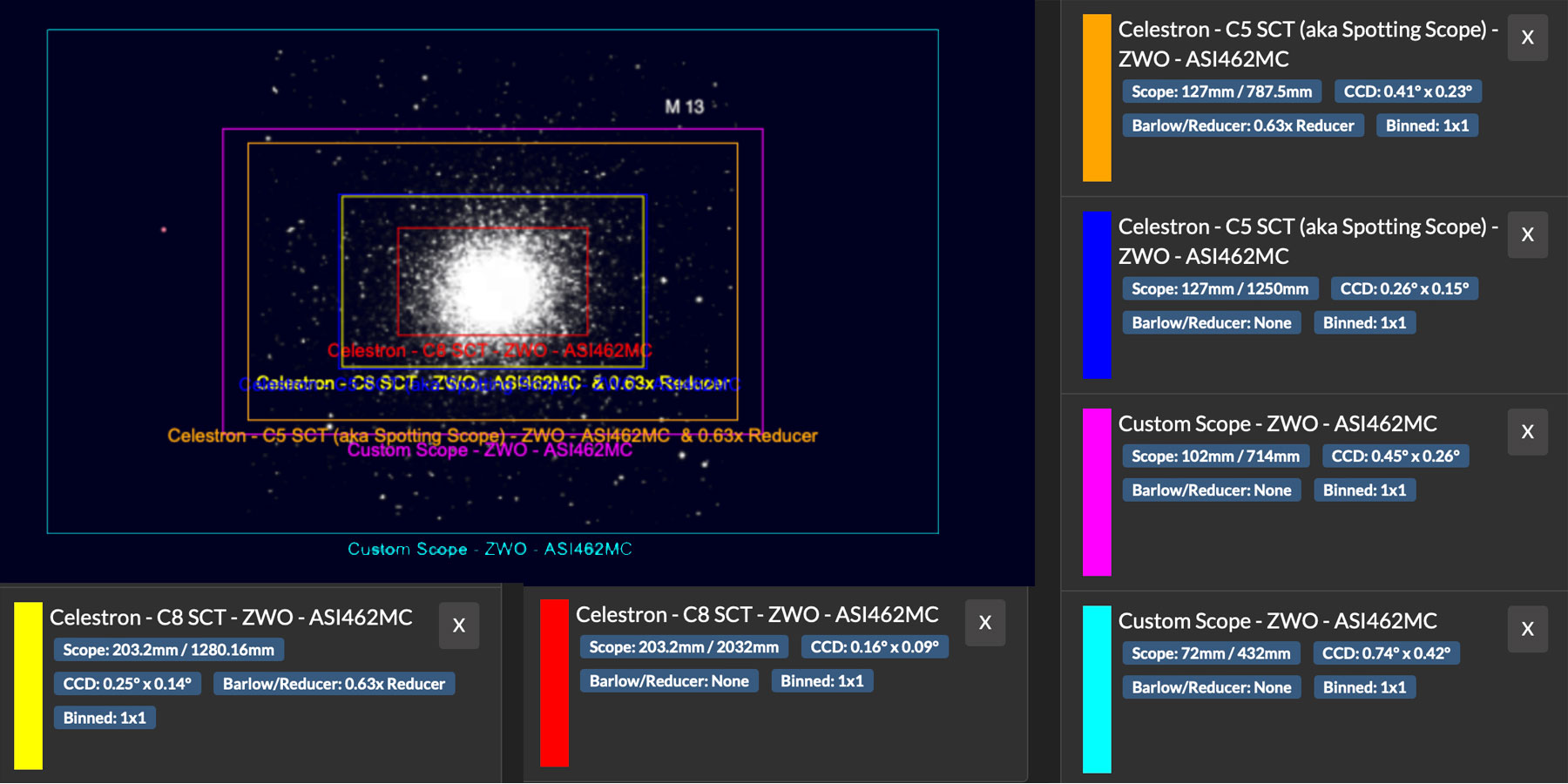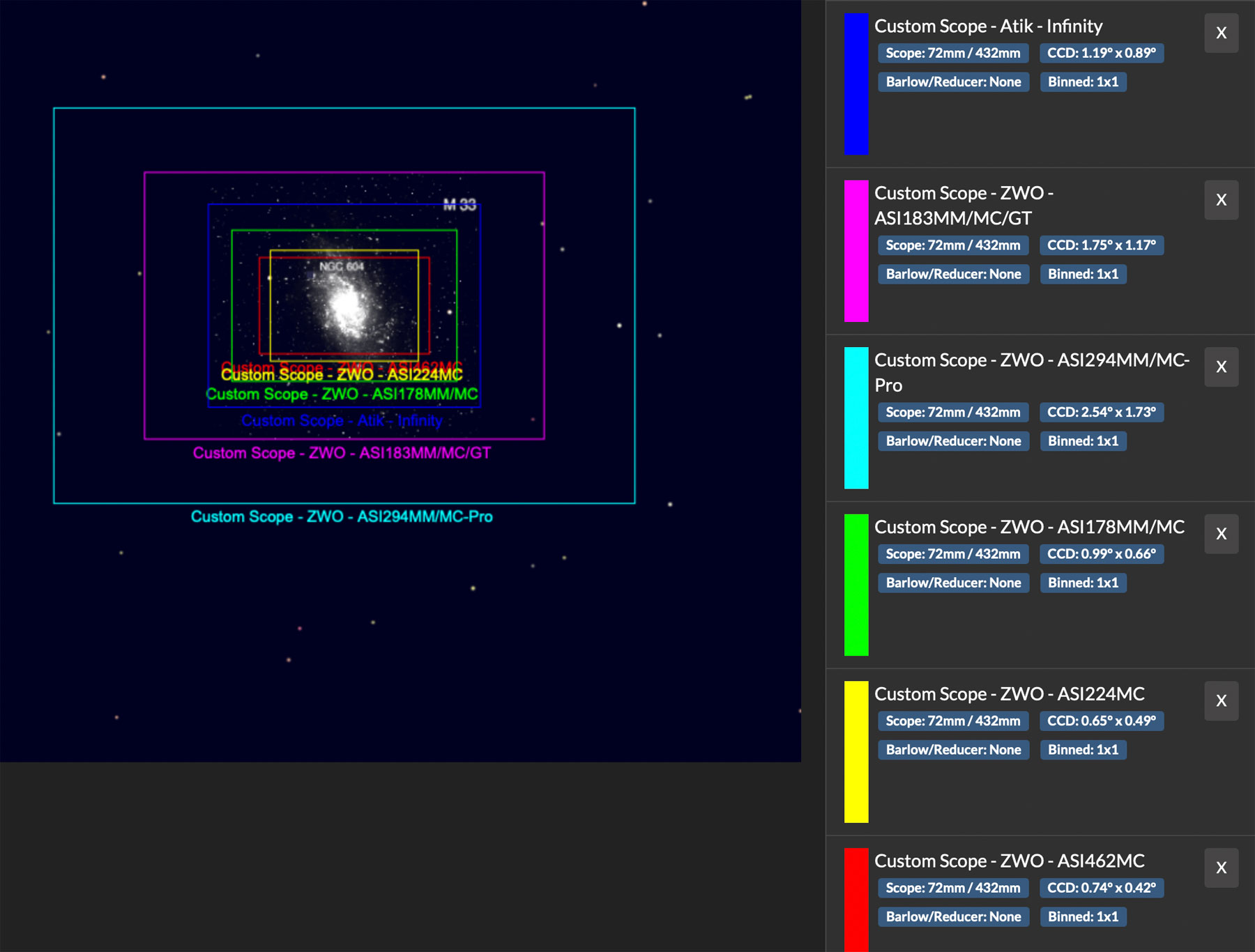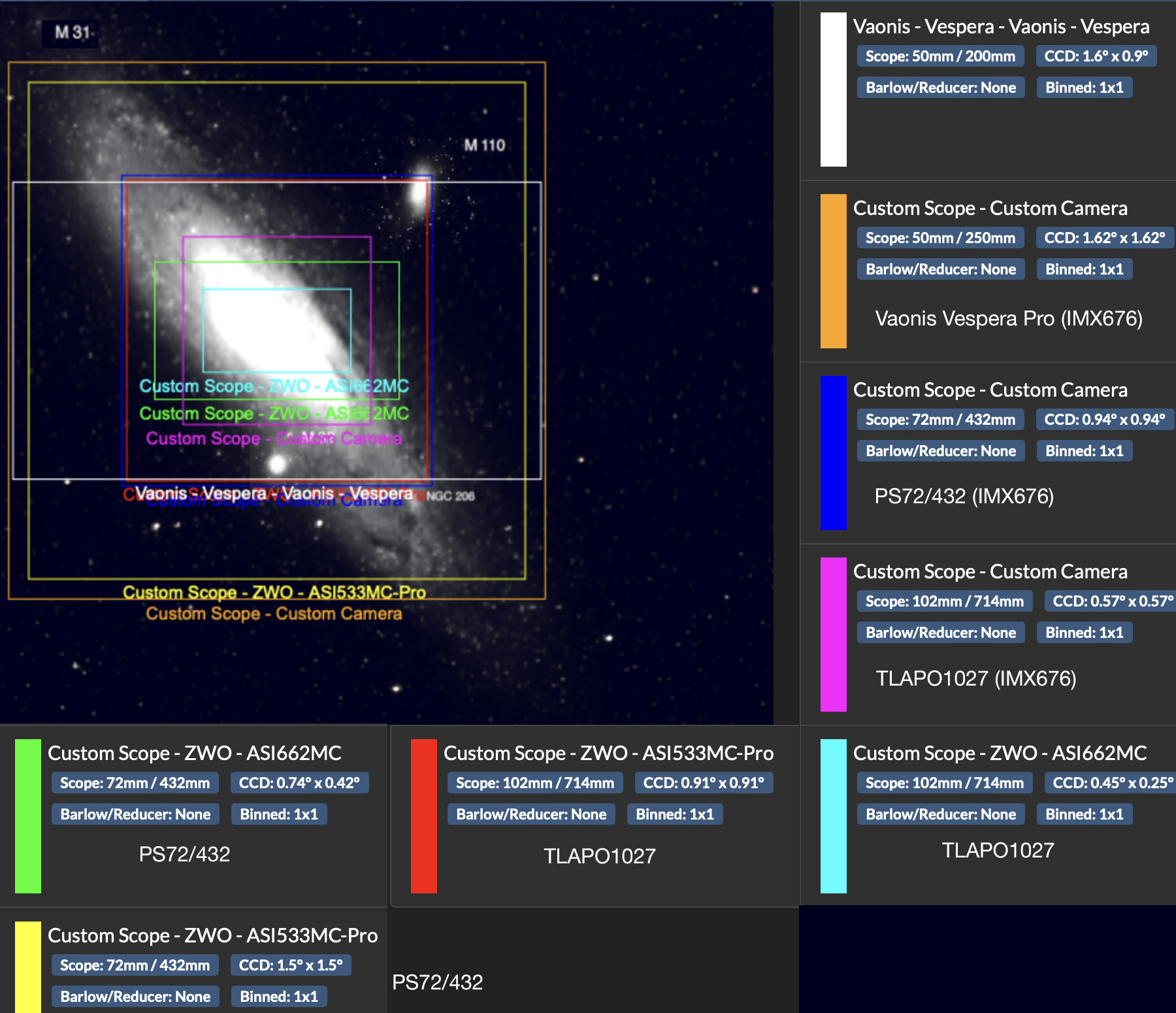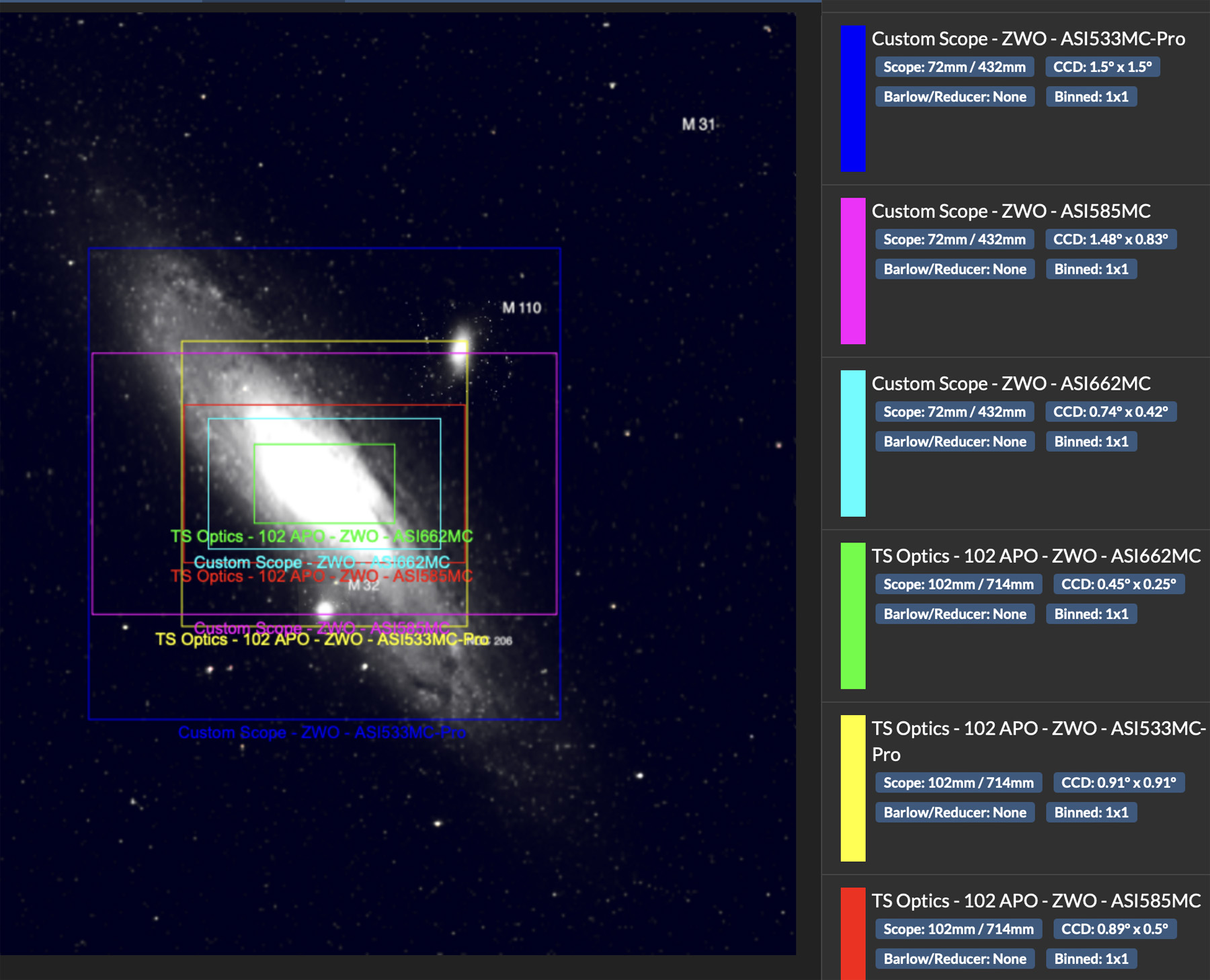EAA - Fields of View
Atik Infinity | ZWO ASI224 | ZWO ASI178 | ZWO ASI533 | ZWO ASI294 | ZWO ASI482/485 (ASI585) | ZWO ASI462 | Overview | Various Cameras at the PS 72/432 | Conclusions | Links || Appendix: Some More Chips...
On this page, I present some more information about EAA (Electronically Augmented Astronomy), in particular, I present the field of view for my current telescope tubes (as of April 2021) and some common astronomy cameras or sensor chips. I used the Website astronomy.tools for calculating the field of view. In any case, this is the most convenient way for doing so!
Note: The results are also valid for other cameras than those listed if they use the same sensor chip and resolution.
At the end of this page, I collect the results in a table.
Atik Infinity
I used the Website astronomy.tools for calculating the field of view of the Atik Infinity camera (Sony ICX825) at my current telescopes (as of April 2021).
Legend: Orange Custom Scope = eVscope; Yellow Custom Scope = PS 72/432; Cyan Custom Scope = C5; Green Custom Scope = C5R (C5 with f/6,3 reducer/corrector)
Note: No longer in my possession
ZWO ASI224
I used the Website astronomy.tools for calculating the field of view of the ASI224 (Sony IMX224/225) camera at my current telescopes (as of April 2021).
Legend: Orange Custom Scope = eVscope; Red Custom Scope = PS 72/432
Note: No longer in my possession
ZWO ASI178
I used the Website astronomy.tools for calculating the field of view of the ASI178 (Sony IMX178) camera at my current telescopes (as of April 2021).
Legend: Orange Custom Scope = eVscope; Red Custom Scope = PS 72/432
ZWO ASI533
I used the Website astronomy.tools for calculating the field of view of the ASI533 (Sony IMX533) camera at my current telescopes (as of April 2021).
Legend: Magenta Custom Scope = PS 72/432
ZWO ASI294
I used the Website astronomy.tools for calculating the field of view of the ASI294 (Sony IMX294) camera at my current telescopes (as of August 2021).
Legend: Magenta Custom Scope = PS 72/432
ZWO ASI482/485 (ASI585*)
I used the Website astronomy.tools for calculating the field of view of the ASI482/485* (Sony IMX482/485) camera at my current telescopes (as of August 2021). The cameras ASI482 and ASI485 offer the same field of view. However, the pixels of the ASI482 have a size of 5,8 µm, whereas those of the ASI485 have one of 2,9 µm.
*) The newer ASI585 (IMX585) has the same FOV data as the ASI485!
Legende: Orange Custom Scope = PS 72/432
ZWO ASI462
I used the Website astronomy.tools for calculating the field of view of the ASI462 (Sony IMX462) camera at my current telescopes (as of August 2021).
Legend: Cyan Custom Scope = PS 72/432, magenta Custom Scope = TLAPO1027
Overview
Field of View
I summarize the results in the following table:
Field of View |
|||||||||||
| Telescope | Red. | FL | Apert. | Atik Infinity* | ASI224* | ASI462 *** |
ASI178* | ASI533* | ASI294 | ASI482/485 (585=485)* |
Remarks |
Pixel Size > |
6.45 µm | 3.75 µm | 2.9 µm | 2.4 µm | 3.76 µm | 4.63 µm | 5.8/2.9 µm | ||||
Pixels > |
1392 x 1040 | 1304 x 976 | 1936 x 1096 | 3096 x 2080 | 3008 x 3008 | 4144 x 2822 | 1920 x 1080/ 3840 x 2160 |
||||
| PS 72/432 | --- | 432 | 72 | 1.19° x 0.89° | 0.65° x 0.48° | 0.74° x 0.42° | 0.98° x 0.66° | 1.50° x 1.50° | 2.54° x 1.73° | 1.48° x 0.83° | The largest FOV |
| C5 | --- | 1250 | 127 | 0.41° x 0.31° | 0.22° x 0.17° | 0.26° x 0.15° | 0.34° x 0.23° | 0.52° x 0.52° | 0.88° x 0.60° | 0.51° x 0.29° | FOV like C8 with reducer |
| C5 | f/6.3 | 787.5 | 127 | 0.65° x 0.49° | 0.36° x 0.27° | 0.41° x 0.23° | 0.54° x 0.36° | 0.82° x 0.82° | 1.40° x 0.95° | 0.81° x 0.46° | FOV a little smaller as with TLAPO1027 |
| C8* | --- | 2032 | 203 | 0.25° x 0.19° | 0.14° x 0.10° | 0.16° x 0.09° | 0.21° x 0.14° | 0.32° x 0.32° | 0.54° x 0.37° | 0.31° x 0.18° | The smallest FOV |
| C8* | f/6.3 | 1280 | 203 | 0.40° x 0.30° | 0.22° x 0.16° | 0.25° x 0.14° | 0.33° x 0.22° | 0.51° x 0.51° | 0.86° x 0.58° | 0.50° x 0.28° | FOV like C5 |
| TLAPO1027* | --- | 714 | 102 | 0.72° x 0.54° | 0.39° x 0.29° | 0.45° x 0.26° | 0.60° x 0.40° | 0.91° x 0.91° | 1.54° x 1.05° | 0.89° x 0.50° | FOV a little larger that for C5 with reducer |
| eVscope** | --- | 450 | 114 | --- | 0.61° x 0.46° | --- | --- | --- | --- | --- | Same chip as ASI224 |
| eVscope 2*** | --- | 450 | 114 | --- | 0.78° x 0.57° | New chip IMX347 | |||||
| Vespera | --- | 200 | 50 | --- | 1.60° x 0.91° | --- | --- | --- | --- | Same chip as ASI462 | |
*) No longer in my possession; *) not in my possession
*) Up to app version 1.2, the eVscope used a sensor resolution of 1280 x 960
pixels. Since app version 1.3 it upscales the sensor image to 2560 x 1920 pixels.
**) Rectangular format: 2048 x 1536 pixels in Live View mode and 3200 x 2400 pixels in Enhanced Vision mode, which are upscaled from 2048 x 1536.
***) Calculated for 1920 x 1080 pixels.
Application Example 1
I operated the C8 visually using the Celestron StarSense module and found that the accessed sky object was rarely at the center after approach, but often rather at the edge of the field of view. With the 26 mm eyepiece that I had used, the field of view was 0.9°, that is, almost one degree (with an 35 or 40 mm eyepiece, the field of view would have been 1.2° to about 1.3°). With a camera/telescope combination offering a smaller field of view, the searched for object will therefore, depending on the size of the field of view, more or less often not be in the field of view and must be searched for laboriously.
Image Scale
The following table was taken from page Telescope and Sensor and simplified:
| Telescope | Image Scale ["/Pixel] |
|||||||
| Examples | Focal Length [mm] |
Aperture [mm] |
f |
Pixel Size [µm] |
||||
2.4 |
2.9 | 3.75 |
4.63 | 6.45 |
||||
| Vespera | 200 | 50 | 4 | 2.48 | 2.99 | 3.87 | 4.78 | 6.65 |
| Stellina | 400 | 80 | 5 | 1.24 | 1.50 | 1.93 | 2.39 | 3.33 |
| TLAPO1027 | 714 | 102 | 7 | 0.69 | 0.84 | 1.08 | 1.34 | 1.86 |
| PS 72/432 | 432 | 72 | 6 | 1.15 | 1.38 | 1.79 | 2.21 | 3.08 |
| eVscope (2), Newton 114/450 | 450 | 114 | 4 | 1.10 | 1.33 | 1.72 | 2.12 | 2.96 |
| Celestron C5 | 1250 | 125 | 10 | 0.40 | 0.48 | 0.62 | 0.76 | 1.06 |
| Celestron C5R | 787.5 | 125 | 6.3 | 0.63 | 0.76 | 0.98 | 1.21 | 1.69 |
| Celestron C8 | 2032 | 203 | 10 | 0.24 | 029 | 0.38 | 0.47 | 0.65 |
| Celestron C8R | 1280 | 203 | 6.3 | 0.39 | 047 | 0.60 | 0.75 | 1.04 |
| Celestron C8R2 | 1016 | 203 | 5 | 0.49 | 059 | 0.76 | 0.94 | 1.31 |
Ideally, the image scale value should lie in a range between 1 and 2. But in many cases, it is admissible that it lies outside this range... Values for the image scale above 2 are called "undersampling", values below 1 are called "oversampling".
Application Example 2
When buying a camera, I ask myself to what extent a camera with a small sensor and low resolution makes sense at all, and whether its image field could not be similarly covered by a camera with a larger sensor. For this, I compare three higher resolution cameras with the ASI224 and choose as telescope the PS 72/432 (the telescope should not really matter - not quite, as we will see...):
- ASI224, 1304 x 976 pixels (3.75µm): Results in a FOV of 0.65° x 0.48° and an image scale of 1,8 "/pixel; a 0.5° object consists of 1003 pixels
- ASI178, 3096 x 2080 pixels (2.4µm): Results in a FOV of 0.98° x 0.66° and an image scale of 1,15 "/pixel; a 0.5° object consists of 1580 pixels
- ASI533, 3008 x 3008 pixels (3.76µm): Results in a FOV of 1.50° x 1.50° and an image scale of 1,8 "/pixel; a 0.5° object consists of 1003 pixels (a tiny bit less than the ASI224...)
- ASI294, 4122 x 2822 pixels (4.63µm): Results in a FOV of 2.54° x 1.73° and an image scale of 2,2 "/pixel; a 0.5° object consists of 811 pixels
- ASI462, 1920 x 1080 pixels (2.9µm): Results in a FOV of 0.74° x 0.42° and an image scale of 1,38 "/pixel; a 0.5° object consists of 1297 pixels
While the pixel size plays a role in how many pixels an object is depicted with, only the number of pixels matters when viewing photos. For the former, the finer the pixels, the more pixels an object is represented with. This can be seen with the ASI178, while the ASI294 with its larger pixels displays objects more coarsely on the same telescope. Finally, this is also reflected in the values for the magnification (see above).
If you want to achieve similar pixel numbers with the ASI294 as with the ASI224, you need a telescope with a longer focal length. For me, the "next" telescope in terms of focal length would be the TLAPO1027:
- ASI294, 4122 x 2822 pixels (4,63µm): Results in a FOV of 1.54° x 1.05° >> 1.34"/pixel; a 0.5° object consists of 1345 pixels
Various Cameras at the PS 72/432
The graph above illustrates the differences between various ASI cameras (and Sony chips) at my PS 72/432 refractor. Thus, you can quickly see that the ASI294 provides the largest field of view of all cameras and that the ASI224 (this chip is used by the original Unistellar eVscope) and the newer ASI462 (this chip is used by the Vaonis Vespera) hardly differ in terms of field of view.
ASI 462: 2.1 MP - 1936 x 1096 pixels, pixel size 2.9 µm, sensor: 1/2.8"- Sony IMX462 CMOS
Conclusions
The graphics and the table for the field of view allow me to quickly determine the field of view for a certain telescope/camera combination. The table for the image scale also provides hints as to the fit of telescope focal length and camera sensor (pixel size). The image scale should lie in a range between 1 and 2, But in many cases, it is admissible that it lies outside this range...
Links
- Astronomy.tools - Field of View Calculator: astronomy.tools/calculators/field_of_view
Appendix: Some More Chips...
In the following, I compare the fields of view of some of the newer sensor chips at my two refractors PS72/432 and TLAPO1027.
IMX676, IMX533, IMX662/462
In the chart above created with astronomy.tools, I compare the ASI533 with square sensor IMX533 with the not yet available IMX676 sensor (intended for the Vespera Pro) and with the 16:9 chip IMX462/662 (both have identical FOV). As you can see, the Vespera Pro will have the largest FOV of all these combinations. At the same telescope, however, the ASI533 has the largest FOV. The lower number of pixels (3008 compared to 3536) is more than compensated for by the larger pixels (3.76 µm compared to 2.0 µm).
See the following example for a comparison of the IMX533 with the IMX585/485!
IMX533, IMX585/485, IMX662/462
Here you can see that the new IMX585 (and thew older IMX485) chip has exactly half the field of view of the square chip IMX533. The IMX585, however, has the smaller pixels (2.9 µm compared to 3.76 µm). The IMX462/662 on the other hand, has half the dimensions of the IMX585, and thus, the same aspect ratio (16:9).
| 07.10.2024 |
